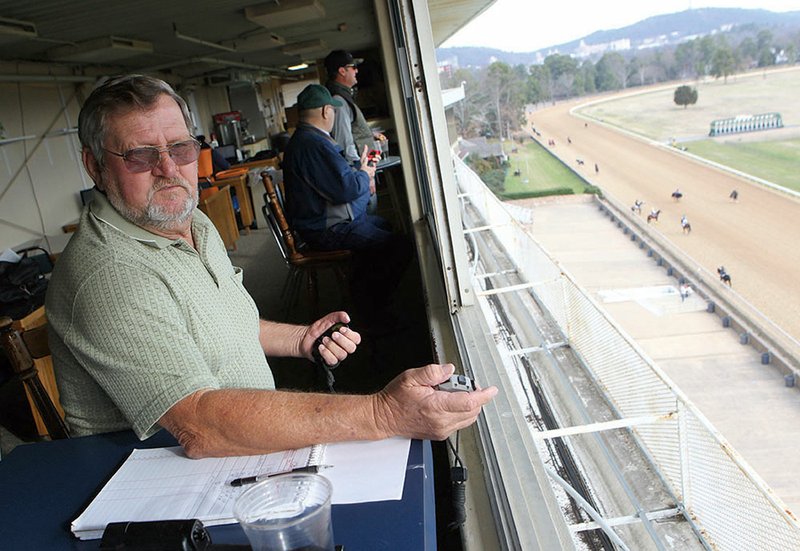EDITOR'S NOTE: A successful live race meet at Oaklawn Park depends on hundreds of employees working a variety of jobs, from making sure the horses are ready to run to ensuring that customers have a memorable day at the races. The Sentinel-Record today continues its weekly series spotlighting the workers who make Oaklawn a success.
Each barn on the backstretch at Oaklawn Park is responsible for anywhere from 20-30 horses during the meet, but the clockers have their eyes on every one that is scheduled to work during morning training hours.
Whether 30 or 300 horses are scheduled for that day, Jim Hamilton, Ronnie Morse and Jerry Bish keep track of each horse's times.
"Basically the trainers call up here and let us know who's working, for how long and we keep the times for each horse," Morse said. "Our job is also more for the public to let them know how well the horses coming up are doing."
The sounds of ringing phones and two-way radios are a constant in the press box during workouts, as Hamilton said he has people at each gap letting him know which horses and riders are entering the track.
"When they break out of the gate, I keep them in order up here and the gate keeper has his list in order," he said. "And we match them up accordingly.
"As far as the rules go, to be eligible to race, an unraced horse has to have three published workouts, while ones that haven't raced in 60 days have to have two published."
Morse said the three are "constantly scanning back and forth" and calling out which horses they are clocking to keep from overlapping or missing horses. A lot is riding on their job, and when asked how they keep track of who they are watching, Morse said saddle towels and markings play a big role.
"There's no typical day or average number for us, but as long as we've not missed any workouts that week it's pretty manageable to keep track of everyone. It's the days after we've had to close the track when you've got that days scheduled ones with the added ones from a few days ago -- however many that might be -- that things get a little hectic."
The track usually opens by 7 a.m. and training continues to 10:30 a.m., with a break to renovate the track from 8:30-9 a.m.
"Seven days a week, we're right here," Bish said. "Usually first thing when the track opens and right after the break are when we get piled up."
Each of the men have been in the racing business in some way or another for much of their lives, as they are all part of racing families. Other job opportunities have come along, but as Hamilton said "you always find your way back."
"I've gone and done things in other lines of work before, but once you've been on the track it's just in you," he said. "I've done everything from hot-walking to training. I grew up around horses and ever since I got out of high school I've done just about everything there is on the track.
"After a few injuries, I had to give up galloping, but I've been an outrider and I've been clocking horses here for over 20 years, and probably 30 years together with Louisiana Downs -- I'm retired from there. I've always wound back up here no matter where I've gone."
When times are kept, the workouts have to be recorded for publication, which is done by the tab writer.
"Our job is easy compared to this guy," Hamilton said of Taylor Radimer, who said he has been keeping tabs on horses for about five or six meets.
"I do a lot of writing, as you can imagine," he said while taking notes amid phone calls. "I've usually got three or four people throwing numbers at me and I'm here recording names and times. Then when I get a minute -- which isn't often -- I try to jump in and clock a little, too.
"It's a hectic job and it's different every day, but I'm hooked."
Radimer said where trainers only have a few horses to watch at a time, it's the clockers in the press box keeping everyone happy.
But it comes with its perks, as many racing fans will never get to see what they do every day.
"We've got the best view of any job out here, I'll say that," Morse said. "It's amazing the sunrises we see up here," adding that they have the best seat in the house when it comes to watching what the thoroughbreds can do.
Local on 01/30/2015